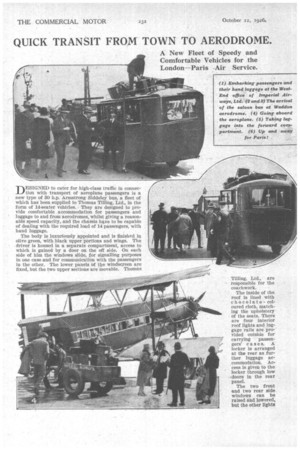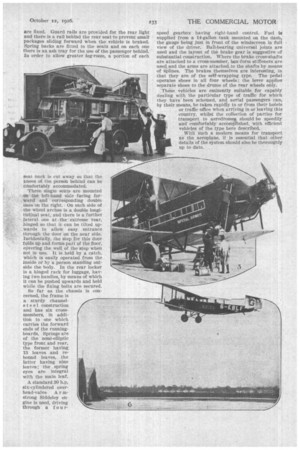QUICK TRANSIT FROM TOWN TO AERODROME.
Page 64

Page 65

If you've noticed an error in this article please click here to report it so we can fix it.
DWONTED to eater for high-class traffic in connection with transport of aeroplane passengers is a new type of 80 h.p. Armstrong Siddeley bus, a fleet of which has been supplied to Thomas Tilling, Ltd.' in the form of 14-seater vehicles. They are designed to provide comfortable accommodation for passengers and luggage to and from aerodromes, whilst giving a reasonable speed capacity, and the chassis have to be capable of dealing with the required load of 14 passengers, with hand luggage.
The body is luxuriously appointed and is finished in olive green, with black upper portions and wings. The driver is housed in a separate compartment, access to which is gained by a door on the off side. On each side of him the windows slide, for signalling purposes in one case and for communication with the passengers in the other. The lower panels of the windscreen are fixed, but the two upper sections are movable. Thomas Tilling, Ltd., are responsible for the coachwork.
The inside of the roof is lined with chocolatecoloured cloth, matching the upholstery of the seats. There are four interior roof lights and luggage rails are provided outside for carrying passengers' case s. locker is arranged at the rear as further luggage accommodation. Access is given to the locker through low -doors in the rear panel.
The two front and two rear side windows can be raised and lowered, but the other lights are fixed. Guard rails are provided for the rear light and there is a rail behind the rear seat to prevent small packages sliding forward when the vehicle is braked. Spring backs are fitted to the seats and on each one there is an ash tray for the use of the passenger behind. In order to allow greater leg-room, a portion of each seat pack is cut away So that the knees of the Person behind can be cOmfortably accommodated.
'Three single seats • are mounted on: the left-hand side facing forWard and corresponding double _Ones on the right. On each side of the :Wheel arches is. a double longltadinal seat, and theite is a further lateral one at . the extreme rear; hinged. so that it can be tilted .upwards to allow easy ;entrance through the door on the near side. Incidenfall3i, the step for this door folds up and forins part of the floor, covering the. well of the step when not in use, It is.held by a catch, which is easily operated from the inside or by a person standing outside the body. In the rear locker is a hinged rack for luggage, having two handles, by means of which it can be pushed upwards and held while the fixing bolts' are secured.
So far as the chassis is concerned, the frame is a sturdy channelsteel construction and has six crossmembers, in addition to one which carries the forward ends of the runningboards. Springs are of the semi-elliptic type front and rear, the former having 13 leaves and rebound leaves, the latter having nine leaves; the spring eyes are integral with the main leaf.
A standard 30 h..p. six-cylindered overhead-valve A r mstrong Siddeley engine is used, driving through a four speed gearbox having right-hand control. Fuel is supplied from a 14-gallon tank mounted on the dash, the gauge being just in front of the windscreen in full view of the driver. Ban-bearing universal joints are used and the layout of the brake gear is suggestive of substantial construction. Where the brake cross-shafts are attached to a cross-member, box-form stiffeners are used and the arms are attached. to the shafts by means of splines. The brakes themselves are interesting, in• that they are of the self-wrapping type. The pedal operates .shoes in all four . wheels ; the lever applies separate shoes to the drums of the rear wheels only. .These vehicles are eminently suitable for capably dealing with the particular type of traffic for which they have been schemed, and aerial passengers can, by their means, be taken rapidly to or from their hotels or traffic office when arriving in or leaving this country, whilst the collection of parties for transport to aerodrom% should be speedily and comfortably accomplished, with efficient vehicles of the type here described.
With Such a modern means for transport as the aeroplane, it is essential that other details of the system should also be thoroughly up to date.












































































































